Above: habitat typical of the southern Hognose snake (Heterodon simus). Jeff allowed us to help him track an individual that he had tagged with a radio transmitter (see Dave above with the antennae). Unfortunately, the individual was underground and we didn't get to see it. Cool habitat, though!
____________________________________________________________________________
Before I end with possibly my favorite encounter of the trip -I must really stress the word possibly in this sentence- , I'm going to fill in the gaps with a few more reptile encounters that aren't really long enough to justify their own post at this point. This is especially true considering that this trip is already going to result in SIX blog posts!
___________________________________________________________________________
The Banded Watersnake (Nerodia fasciata). Up in our neck of the woods we have the Northern Watersnake (Nerodia sipedon), which I've posted about before. In the Sandhills, for some reason, the Northern Watersnake is replaced with the Banded Watersnake. Both have similar ecological needs (habitat, food, etc.). Why one likes the Sandhills and one likes the Piedmont...who knows? Maybe the Banded Watersnake can better handle the drier conditions in the Sandhills? The two species are found sympatrically (together) in the areas where the Piedmont and the Sandhills meet, and will apparently hybridize (reviewed by Gibbons and Dorcas in their 2004 book: North American Watersnakes: a natural history, University of Oklahoma Press).
Regardlesss, this species was fairly common around the hatchery. I saw more than one dive into the water from the rip-rap along the banks before I could hope to get a hand on them (and I have to admit being more hesitant here, because I knew there were Cottonmouths around).
I've found very similar scenarios in the upper Midwest with fish hatcheries and watersnakes (although up there we only have the Northern Watersnake). These hatcheries attract amphibians, which are a primary food source for most watersnake species. In fact, I recall catching a few Northern Watersnakes in Wisconsin at a hatchery, only to have one vomit up three freshly eaten Bullfrog tadpoles.
The biggest issue with watersnakes is that they are stinky! If you grab one be prepared to get musked with some of the most unpleasant-smelling fluid that comes from an animal, this side of a skunk.
Oh....and they're also biters...but that's as much a badge of honor as anything. I actually prefer the biting to the musking. ;)
Above: three pictures of a Banded Watersnake that was captured at the hatchery during our trip to the Sandhills. If you ask me, it's quite a pretty individual. The pattern on the head is very nice.
________________________________________________________________________
Yellow-Bellied Sliders (Trachemys scripta scripta): There is a drainage ditch that runs through a portion of the fish hatchery property. There is a point where this ditch runs into a cement pit....and the water is apparently then directed back to a natural stream...or maybe the sewer...I'm not sure. Anyways, it's a trap for alot of herps...they fall in and can't get out. I'm told that folks who visit the hatcher and are in-the-know always check the pit.
This time, the pit contained a handful of hatchling Yellow-Bellied Sliders.
Above: two pictures of hatchling Yellow-Bellied Sliders found in the cement trap at the hatchery. Note the black dots on the humeral scutes of the plastron. These distinguishes this species from the River Cooter.
Yellow-bellied sliders can be difficult to distinguish from the River Cooter (Pseudemys concinna concinna). Both are dark with yellow lines around their heads and arms....both have yellow plastrons (lower shells). But most of the time the Yellow-bellied Slider has characteristic dark circles or dots on the humeral scutes near the head (see pictures above).
These turtles are related to the Red-eared Slider (Trachemys scripta elegans), which is often sold in pet stores. The Red-eared Slider is also an invasive species in many areas around the world, as pets are often released in water bodies outside of their natural geographic range.
__________________________________________________________________________
Southestern Five-lined Skink (Plestiodon inexpectatus): I've posted about finding the plain-old Five-Lined Skink (Plestiodon fasciatus) back up in the Piedmont. The Southeastern Five-Lined Skink is very similar....and basically can be distinguised by counting the number of labial, or mouth, scales between the eye and the nostril, or looking at the size of the scales that line the underside of the tail. Either way, it requires you to catch them and scrutinize them pretty closely.
We found oodles of these guys flipping boards and pieces of tin....pretty much everywhere we went.
Members of this genus (Plestiodon, which used to be Eumeces) are very common in our fine state. Usually associated with fallen woody debris (bark, logs, leaf-litter) in woodlands or semi-open woodlands. They root around for invertebrates. The picture of the male, sporting the red-head, is one I've posted before. This was an individual that we found on our Sandhills trip.
Above: Skinks like to bite! It's a last ditch effort to escape predation. They will also undergo what is technically referred to as caudal autotomy. This is where an individual purposefully separates its tail from its body. The animal usually does this when captured by a predator.....the tail keeps wiggling after it has been separated, and apparently distracts the predator enough for the skink to make a hasty escape.
Above: Skinks even make good living jewelry for the fashion-savy individual on a budget.
_____________________________________________________________________
Only one more post focused on what we found during our trip to the sandhills is forthcoming.
Stay tuned!
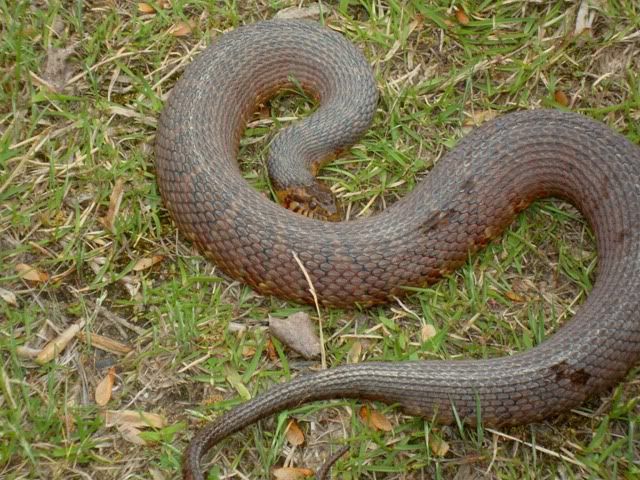

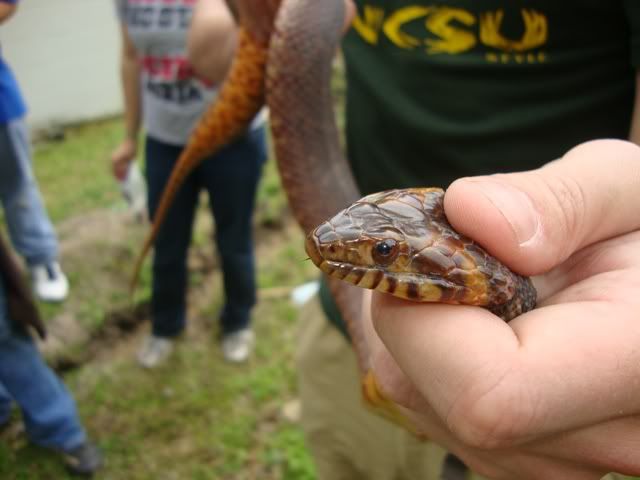
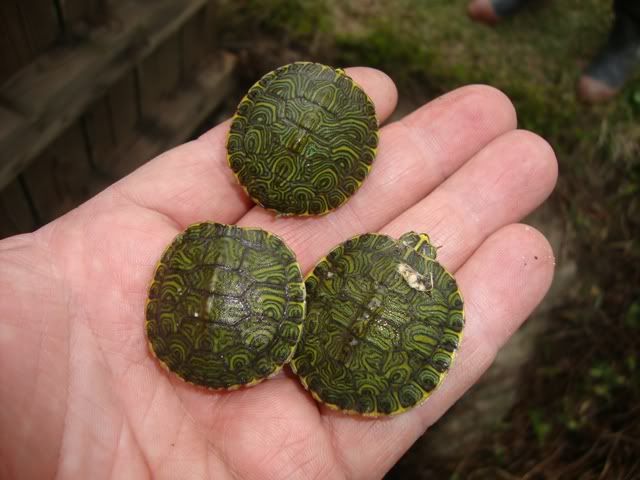
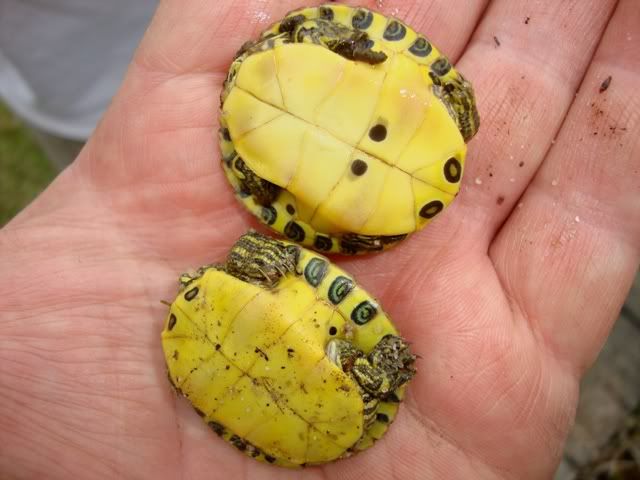
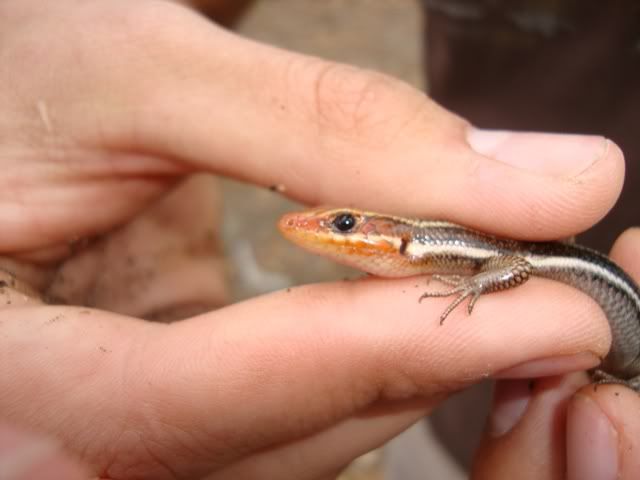
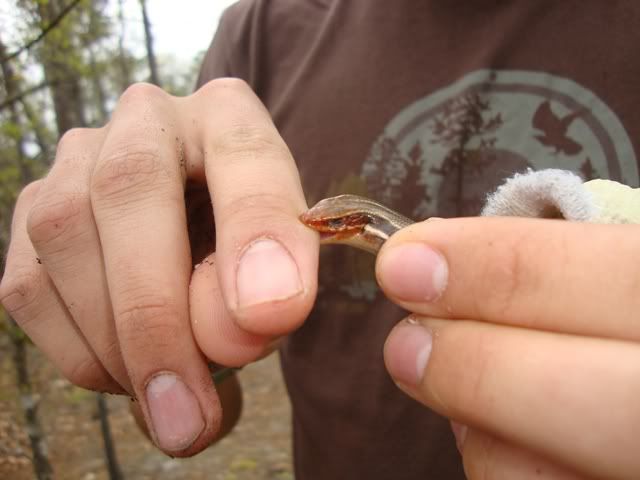
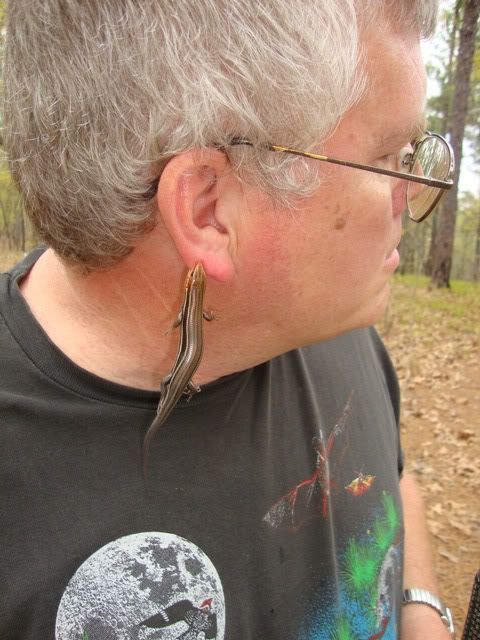
I know all about biting skinks. Believe it or not, I once ran them on treadmills!
ReplyDeleteHey KB.
ReplyDeleteSounds fun! You must have been doing some physiology research? Everyone I've known who has done herp physiology work runs lizards on treadmills, it seem... ;)